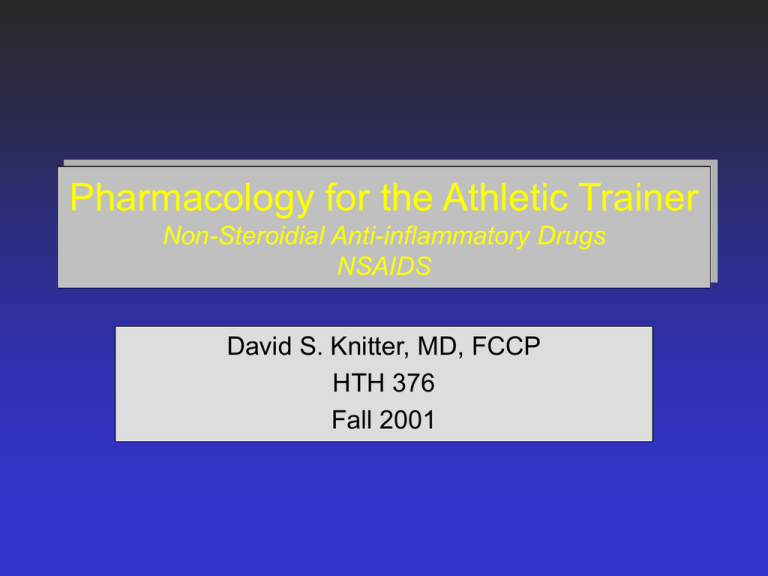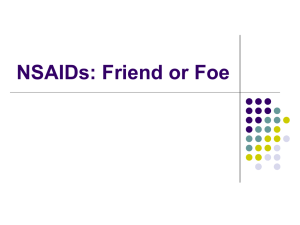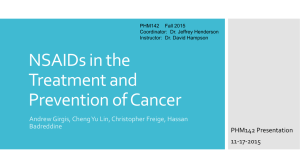Patients not taking aspirin
advertisement

Pharmacology for the Athletic Trainer Non-Steroidial Anti-inflammatory Drugs NSAIDS David S. Knitter, MD, FCCP HTH 376 Fall 2001 In 1997, the Nonprescription Drug Manufacturers Association (NDMA) published the report of a study conducted by Kline & Co. and subtitled "Economic Benefits of Self-Medication." “The economic analysis resulted in an estimate that OTC availability for the categories studied resulted in savings to the consumer of $20.6 billion annually when compared with the costs of treating the ailments using physicians and prescription medications. The researchers estimated that nearly two-thirds of the calculated savings could be traced to Rx-to-OTC switched products.” Rise In OTC Sales Category 1996 ($ in millions) 2001 ($ in millions) Analgesics 935.1 1,262.6 % average annual growth rate 7.5 Antifungal (vaginal) 233.0 253.7 14.7 Smoking cessation 53.0 410.0 51.0 Product Percent of sales dollars of top 21 OTC products Advil 9.0% Aleve 4.0 Motrin IB 3.0 NSAID Classes Acetylated Salicylic acid Non-Acetylated Salicylic acid Acetic acid derivatives Aspirin Difunisal Choline salicylate Choline-magnesium trisalicylate Sodium salicylate Salsalate Magnesium salicylate Indomethacin Sulindac Toletin Etodolac Diclofenac Propionic Acids Fenamic acids Enolic acids Fenoprofen Flurbiprofen Ibuprofen Ketoprofen Naproxen Oxaprozin Meclofenamate Piroxicam Phenylbutazone Current OTC NSAIDs • Aspirin 325mg not to exceed 4 grams in 24 hours • Ibuprofen 200mg not to exceed 1200 mg in 24 hours • – Advil – Nuprin – Mortin AB Naprosyn 200mg not to exceed 600mg in 24 hours • – Aleve Ketoprofen 12.5mg not to exceed 75mg in 24 hours – Orudis KT Prostaglandin (PG) Synthesis • Prostaglandins have been implicated in pathogenesis of inflammation and fever • Aspirin-like drugs inhibit the biosynthesis and release of PGs • Inhibition of the synthesizing enzyme (cyclo-oxygenase) is fairly well correlated with anti-inflammatory action Inhibition of COX2 (inducible) may be responsible for therapeutic effects of NSAIDs Inhibition of COX1 (constituitive) may be responsible for many adverse effects of NSAIDs Prostaglandin (PG) Synthesis Pain • Direct administration of PGs causes local pain evidence suggests that PGs (PGE2?)sensitizes pain receptors to bradykinin, a local mediator of pain released during inflammation • Aspirin is less effective against sharp pain (direct stimulation of nerve endings - no PGs, opioids more effective) than against the dull, throbbing pain of inflammation (involves PGs) Prostaglandin (PG) Synthesis Fever • Infection bacterial endotoxins cause release of endogenous pyrogens from neutrophils • Tissue damage or inflammation interleukin 1 released by macrophages (principal role is to activate lymphocytes) affects hypothalamus • Aspirin-like drugs work by increasing heat loss (vasodilatation of peripheral blood vessels) not by reducing heat production Adverse Effects • Gastrointestinal Effects nausea and vomiting stimulation of CTZ in medulla gastric bleeding 3-8 ml/day blood loss with 4-5 g aspirin/day vs 0.6 ml in untreated subjects • Blood Clotting aspirin irreversibly inhibits platelet synthesis of thromboxane A2 (TXA2) which is required for aggregation other NSAIDs - reversible effect on clotting non-acetylated salicylates - no effect on clotting terminate chronic use of aspirin 1 week prior to elective surgery (most other NSAIDs 24-48 hr) Adverse Effects • Salicylism characterized by tinnitus (may be related to increased labyrinthine pressure or effect on cochlear hair cells, pehaps secondary to vasoconstriction of auditory microvasculature), headache, nausea and vomiting, dizziness and dimness of vision • Aspirin Hypersensitivity or ”Aspirin Intolerance" 1/4 million in USA symptoms include rhinitis, profuse watery secretions, bronchial asthma, bronchconstriction, hypotension, vasomotor collapse, coma non-acetylated salicylates may be used cautiously Adverse Effects • Reye's syndrome rare but often fatal consequence of infection with varicella and various other viruses salicylates are contraindicated in children and adolescents with chicken pox or influenza Acetaminophen • Little or no anti-inflammatory activity • Mechanism of action is unknown Very weak inhibitor of cyclo-oxygenase Greater effect in the CNS ?? • Minimal gastrointestinal irritation • No effect on bleeding time Acetaminophen Toxicity • Hepatic necrosis (acute 10-15 g; >25 g usually fatal) • Increased incidence of hepatotoxicity in the presence of ethanol and/or fasting (with as little as 4 g/day) • Ethanol induces hepatic MFO metabolism (pathway 3) shifting reaction toward toxic metabolite (limited glutathione available) Renal Tubular Necrosis • Increased risk with lifetime intake • Associated greater than 1000 tablets of acetaminophen • Associated greater than 5000 tablets of NSAIDs • ? effect of aspirin • Gastrointestinal toxicity from NSAIDs is an important cause of morbidity and mortality in the United States. Severe complications primarily include gastrointestinal hemorrhage, ulcer perforation, and bowel obstruction. Among long-term users of NSAIDs, the mortality rate from gastrointestinal complications is 0.22% per year (1). However, with such a large population of regular users, NSAIDrelated gastrointestinal complications rank 15th among the most common causes of death in the United States (table 1: not shown). • Do the new drugs celecoxib (Celebrex) and rofecoxib (Vioxx) reduce risk for clinically relevant gastrointestinal toxicity compared with the older NSAIDs? Theoretically, there are reasons to suggest that celecoxib and rofecoxib might be safer. Both celecoxib and rofecoxib selectively inhibit cyclooxygenase2 (COX-2) and spare cyclooxygenase-1 (COX-1). In human physiology research (23), COX-2 suppression decreased joint inflammation, pain, and fever. By sparing inhibition of COX-1, selective COX-2 inhibitors permit COX-1-mediated generation of prostaglandin E2 and thromboxane A2. Prostaglandin E2 has a physiologic role to protect the gastrointestinal mucosa from ulceration. Thromboxane A2 in platelets is important in hemostasis (23). The physiology of COX metabolism gives a theoretical rationale for development of drugs that selectively inhibit COX-2. In theory, selective COX-2 inhibitors should retain the analgesic and anti-inflammatory efficacy of older NSAIDs while demonstrating improvement in gastrointestinal toxicity Table 5a. Comparison of annualized event rates for symptomatic ulcers plus ulcer complications (perforation, obstruction, bleeding) with NSAID use Dose Event rate NNT (95% CI) Patients not taking aspirin Celecoxib 400 mg bid 1.4% 67 (36 to 468) NSAID Ibuprofen 800 mg tid; diclofenac 75 mg bid Patients taking aspirin* Celecoxib Same as above 2.9% NSAID 6.0% Same as above 4.7% Not significant Table 5b. Comparison of event rates for gastrointestinal adverse effects** with NSAID use Dose Event rate NNT (95% CI) Patients not taking aspirin Celecoxib 400 mg bid 8.0% 47 (28 to 144) NSAID Ibuprofen 800 mg tid; 10.1% diclofenac 75 mg bid Patients taking aspirin* Celecoxib Same as above 11.2% Not significant NSAID Same as above 13.1% Table 6. Comparison of event rates for rofecoxib and naproxen Dose Event rate NNT or NNH (95% CI) Complicated confirmed upper gastrointestinal events (annualized)* Rofecoxib 50 mg daily 0.6% 125 (80 to 293) Naproxen 500 mg bid 1.4% Other gastrointestinal side effects (total events during trial)** Rofecoxib 50 mg daily 3.5% 72 (44 to 200) Naproxen 500 mg bid 4.9% Myocardial infarction (total events during trial) Rofecoxib 50 mg daily 0.4% 338 (186 to 1,822) Naproxen 500 mg bid 0.1% • In one cost-utility estimate (26) published before CLASS or VIGOR, the cost to treat with celecoxib or rofecoxib was $400,000 per year to prevent one complicated ulcer in rheumatoid arthritis patients at low risk of gastrointestinal complications. When one is treating patients at high risk, the costs to use these drugs may be more reasonable. The annual cost estimate was $30,000 to treat high-risk patients with celecoxib or rofecoxib to prevent one complicated ulcer. In light of the CLASS and VIGOR results, formal pharmacoeconomic analyses are needed. Because COX-2 inhibitors do not reduce gastrointestinal risks in aspirin users, future decision analyses should address the competing hazards of myocardial infarction and stroke in patients who forego aspirin prophylaxis to take a COX-2 inhibitor. The small risk of myocardial infarction is a real risk to be considered, as demonstrated by the VIGOR study







